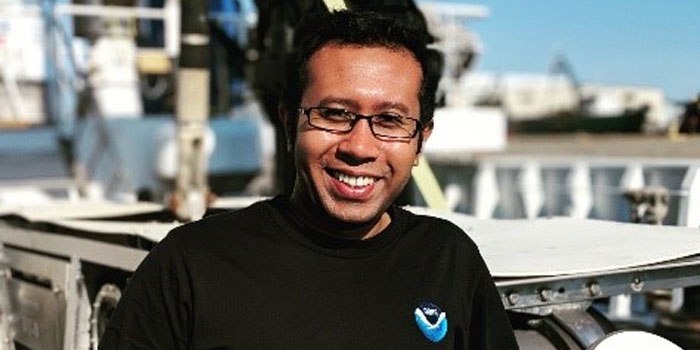
Meet Akim Mahmud
Read the full text of Akim's interview below to learn more about his experiences.
About Akim's Role
What were your duties as an Explorer-in-Training?
I participated in the Mapping Deepwater Areas off the Southeast U.S. in Support of the Extended Continental Shelf Project expedition. It was a 24-day long 24/7 mapping expedition in the east of the Blake Plateau, northeast of the Bahamas.
On board NOAA Ship Okeanos Explorer I worked as a night watch stander working alongside with mapping watch leads and senior hydrographic survey technician. My primary responsibilities included, but not limited to, acquiring and processing daily Kongsberg EM302 multibeam eco sounder bathymetric, backscatter, and water column data using QPS software Qimera and Fledermaus geocoder toolbox FMGT. I also processed Knudsen chirp sub-bottom profiler data as well as kept a good record of all types of data acquisition and processing. I was also trained to perform routine expandable bathythermographs (XBT), a probe used to measure temperature in the water column. Occasionally, I took readings of marine aerosol layer for NASA using an instrument called a sun photometer. Somedays I prepared daily bathymetric products for onshore scientists and mission personnel. For the final project, I focused on refining and updating an in-house standard operation procedure (SOP). In addition to these duties, I observed regular CTD operations and took part in mandatory ship safety trainings.
Which school are you attending, or did you recently graduate from?
I received my B.S. in Earth and Atmospheric Sciences from the City College of New York with a minor in Economics. I completed my M.S. in Marine Science from the Coastal Carolina University with a focus on coastal and marine geology. I am currently enrolled in the advanced GIS program at Johns Hopkins University.
Where was your work experience located? If you were working at sea, what were your impressions of living and working on a ship?
My work office was onboard NOAA Ship Okeanos Explorer, the only U.S. federal vessel, and one of the very few state-of-art ships in the world, purely dedicated to ocean exploration. I have been a huge fan of Okeanos’s popular live telepresence video streams and watching it all happening in front my of eyes right in the mission control room was an incredible working experience. It was my first time working on a research vessel and I learned a lot about general hands-on scientific and ship operation activities from every individual I interacted with in a short period of time. I was really impressed by the living conditions on board. The ship is equipped with all most everything; comfy cabins, library, movie and game rooms, gym, great food, and even unlimited ice cream. Additionally, the NOAA Corps officers and other crew members organized various fun activities around the clock that kept us entertained.
And finally, the sunset and the Milky Way galaxy! Almost every afternoon and some clear nights watching the sunset and Milky Way galaxy from the ship deck in the middle of the ocean will remain imprinted on my memory for the rest of my life!

Sunset over the Bahamas from the ship deck.
What sparked your initial interest in ocean sciences?
I grew up next to Bay of Bengal, Bangladesh where access to ocean was in my footsteps. I always knew oceans can be vast, complex, and mysterious but the opportunity to go explore was limited. While working on a seafloor mapping research project with the U.S. Geological Survey in Woods Hole, MA, my love for oceans was reinforced and eventually guided me to many ocean related opportunities, including this experience.
What was the most personally rewarding part of your experience?
The deep ocean is the final frontier on planet Earth and exploring this mysterious world beneath the waves with Okeanos Explorer was personally a very humbling experience. But the most rewarding part of the experience that I was able to interact with all of the scientists, interns, and ship crew. Their hard work, aspiration, and dedication towards the common goal of exploring the unknown inspired me a lot. I was in company with some of the most knowledgeable and friendly mission personnel, and listening and learning from their experience was truly eye opening.
What is the most unexpected thing you have learned?
It was my first sea-going voyage, so everything was quite unexpected in the beginning. But with the guidance of all the amazing mission personnel, I was able to adopt to sea life quickly. But it was interesting to see the level of detailed preparation and collaboration between mission personnel and ship crew to execute the expedition successfully. In the age of super computer and internet of things, I have learned how ship crews on the bridge still use pen and paper and simple handheld devices, and even stars to navigate the ship in case of any emergencies. The art of ancient seamanship and power of super computers all co-exist in one place on board Okeanos Explorer.
How do you see this experience fitting in with your future career plans?
Considering my past academic background, current involvements, future goals, I cannot imagine being successful in any career that does not involve ocean sciences. My experience onboard Okeanos Explorer exposed me to detailed technical expertise in seafloor mapping techniques and underwater technology along with a networking opportunity that will be helpful in my future career. I appreciate all the crew members and give thanks to the NOAA Office of Ocean Exploration and Research for this amazing opportunity.